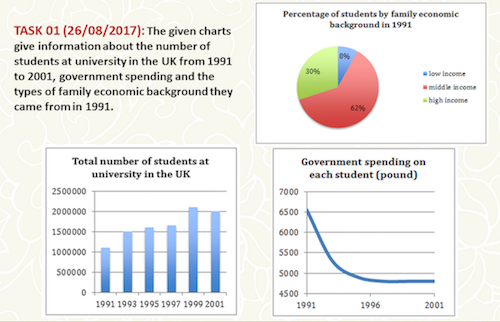Admission rates to British schools
The given charts give information about the number of students at university in the UK from 1991 to 2001, government spending and the types of family economic background they came from in 1991.
A chart table, line graph and pie chart compare the total of British undergraduates, national student subsidy in pounds and family financial situations from 1991 to 2001. Family financial levels comprise low income, middle income and high income. Students grants were offered by government in pounds.
Overall, the number of undergraduates increased and peaked in 1999. Otherwise, there was a downward trend in student grants by government. The majority of students pursuing higher education came from middle income families in 1991 whereas one in eight students were born in the low income.
Clearly, the year 1991 saw 62% of 1.1 million university admissions were students having middle income families. They were the most financially supported throughout the period by the government with comparatively 6500 pounds each. The figure for undergraduates mounted to the highest of 2.1 millions whose personal government subsidy hit the bottom at 4750 pounds in 1999. It remained to finance 2 million students respectively in 2001.
Although the gross of British would-be graduates doubled from 1991 to 1999, the 2001's total registered a slight fall to 2 million. Also, government budget allocated per students decreased sharply from above 6000 to around 4500 pounds which persisted for the last two years of the period. However, students born in wealthy families were half as many as the middle income one, 30% versus 62%.

Slide1.png
